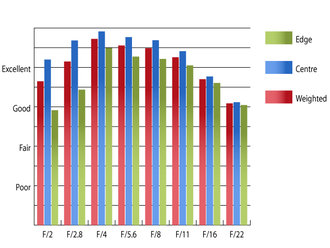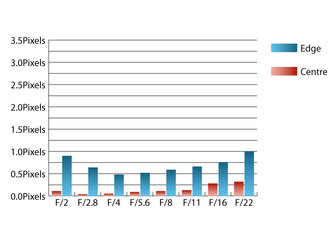Canon EF 35mm f/2 IS USM Lens Review
Canon EF 35mm f/2 IS USM Performance
Sharpness is already excellent in the centre of the frame at maximum aperture, although the clarity towards the edges of the frame lags behind, just falling short of good levels. Stopping down the aperture as far as f/4 improves clarity across the frame, resulting in outstanding sharpness across the frame.  Resolution at 35mm | How to read our chartsThe blue column represents readings from the centre of the picture frame at the various apertures and the green is from the edges. Averaging them out gives the red weighted column.The scale on the left side is an indication of actual image resolution. The taller the column, the better the lens performance. Simple. For this review, the lens was tested on a Canon EOS 6D using Imatest. |
Chromatic aberrations are a little higher than you might expect from a lens of this type. Fringing is strongest at f/2 and f/22 where chromatic aberrations approach one pixel width in size. This level may start to become noticeable, especially around high contrast edges towards the edges of the frame.
 Chromatic aberration at 35mm | How to read our chartsChromatic aberration is the lens' inability to focus on the sensor or film all colours of visible light at the same point. Severe chromatic aberration gives a noticeable fringing or a halo effect around sharp edges within the picture. It can be cured in software.Apochromatic lenses have special lens elements aspheric, extra-low dispersion etc. to minimize the problem, hence they usually cost more. For this review, the lens was tested on a Canon EOS 6D using Imatest. |
Falloff of illumination towards the corners of the frame is quite pronounced at maximum aperture. At f/2 the corners are 2.67 stops darker than the image centre and visually uniform illumination is achieved until the aperture is stopped down to f/5.6 or beyond.
Only a mild level of 1.18% barrel distortion is present, which shouldn't pose too many issues for normal picture taking. However the distortion pattern is not completely uniform across the frame, having a slight wave to it, which may make applying corrections in image editing software afterwards a little more tricky.
No lens hood is supplied as standard by Canon, which is a shame. Even so, this lens seems reasonably resistant to flare, so it should be possible to get by without a hood for all but the most extreme light conditions.
Add your message
Login required
Please login here or if you've not registered, you can register here. Registering is safe, quick and free.
Please login here or if you've not registered, you can register here. Registering is safe, quick and free.
photodo Stats
1102 lenses
428 MTF tests
74 in-depth photodo reviews
100+ users join each day
Help the lens community by reviewing or rating a lens today via our lens search
428 MTF tests
74 in-depth photodo reviews
100+ users join each day
Help the lens community by reviewing or rating a lens today via our lens search
Latest Lens Reviews
- Chinon 28mm f/2.8 Vintage Lens Review
- Canon EF 70-200mm f/4L IS II USM Lens Review
- Samyang AF 85mm f/1.4 EF Review
- Sigma 70mm f/2.8 DG Macro Art Review
- Samyang AF 24mm f/2.8 FE Review
- Meike 50mm f/1.7 Review
- Tamron 70-210mm f/4 Di VC USD Review
- Lensbaby Burnside 35mm f/2.8 Review
- Asahi Super Takumar 50mm f/1.4 Review
- Asahi Super-Multi-Coated Takumar 135mm f/3.5 Review
